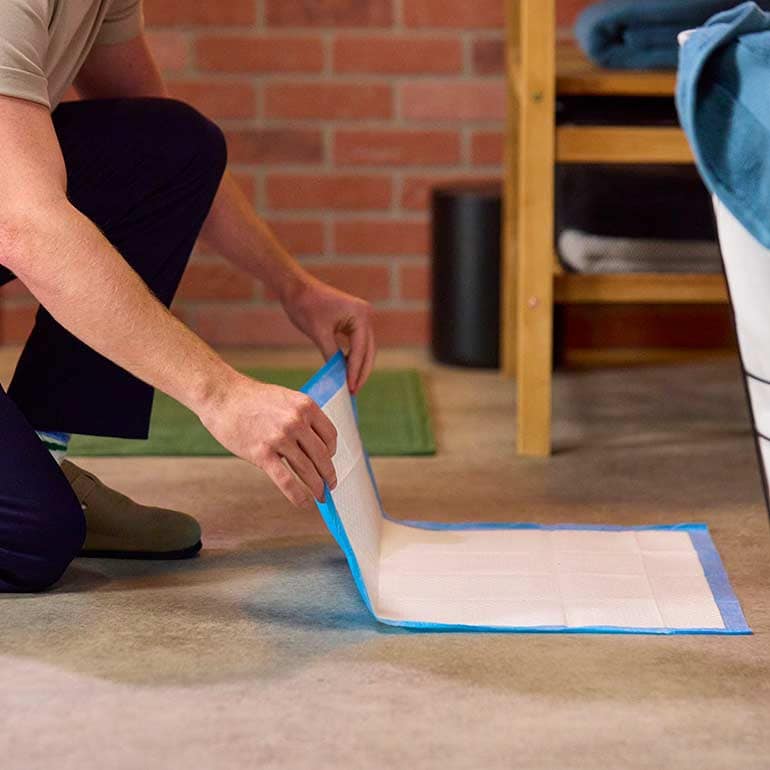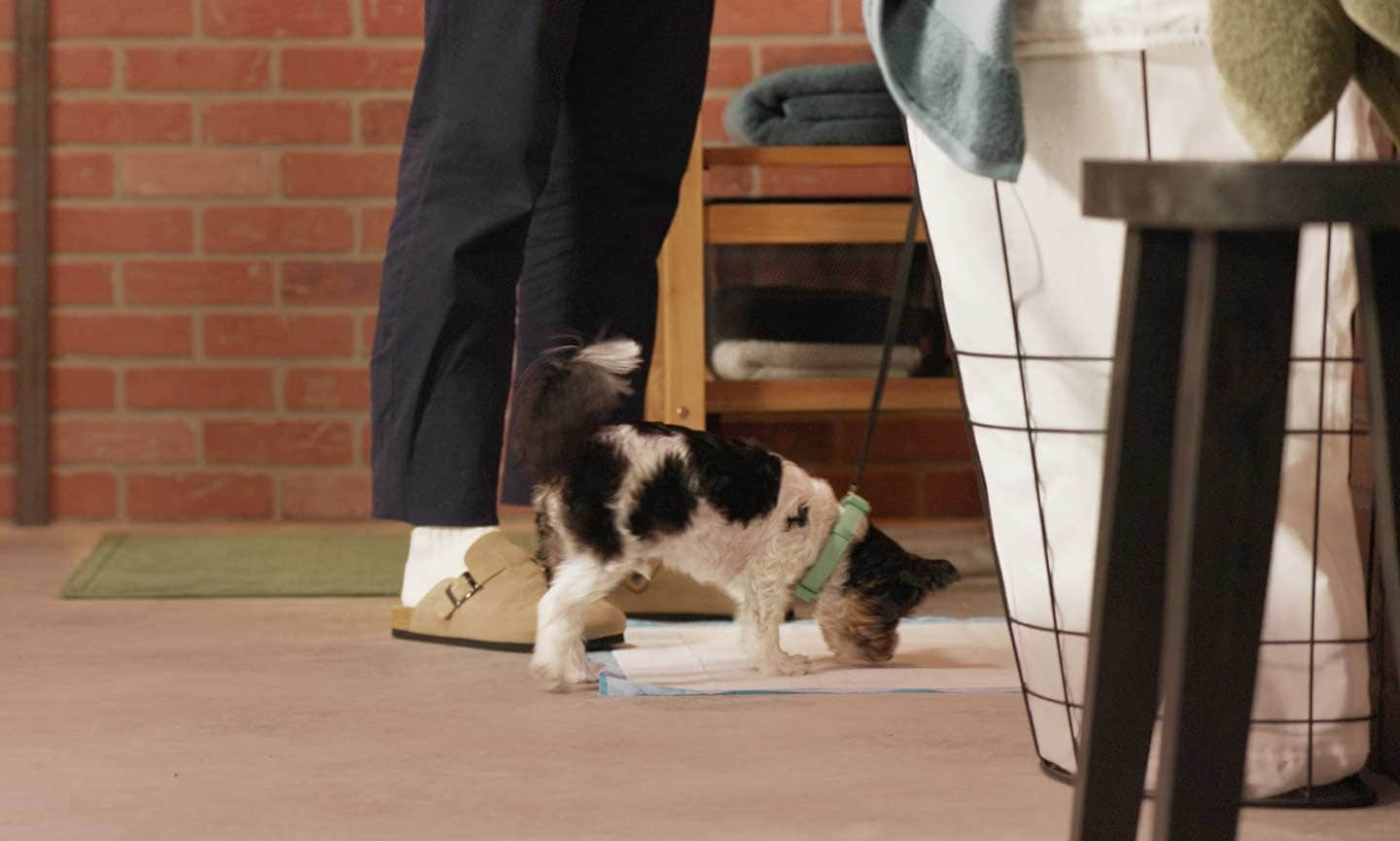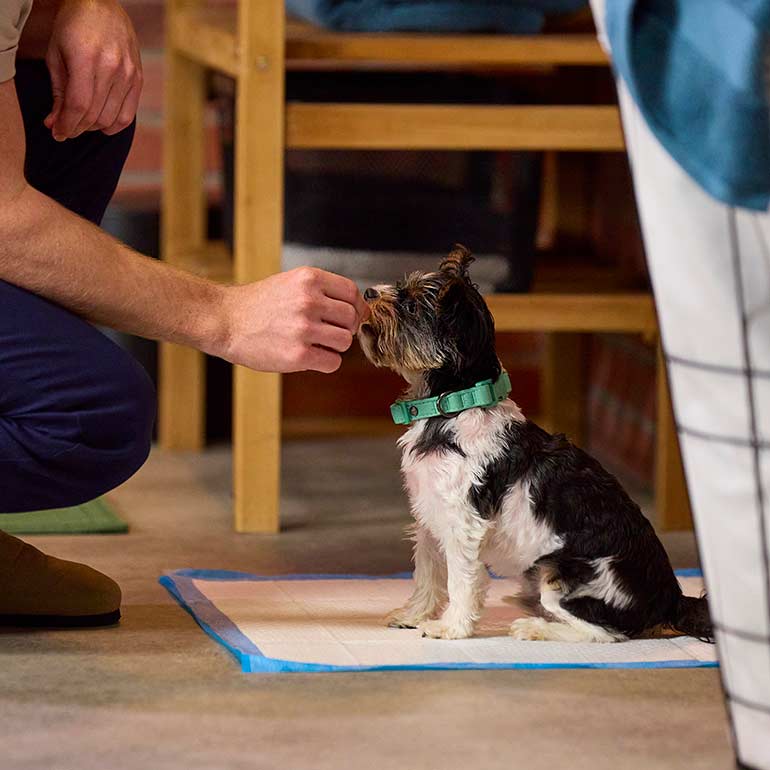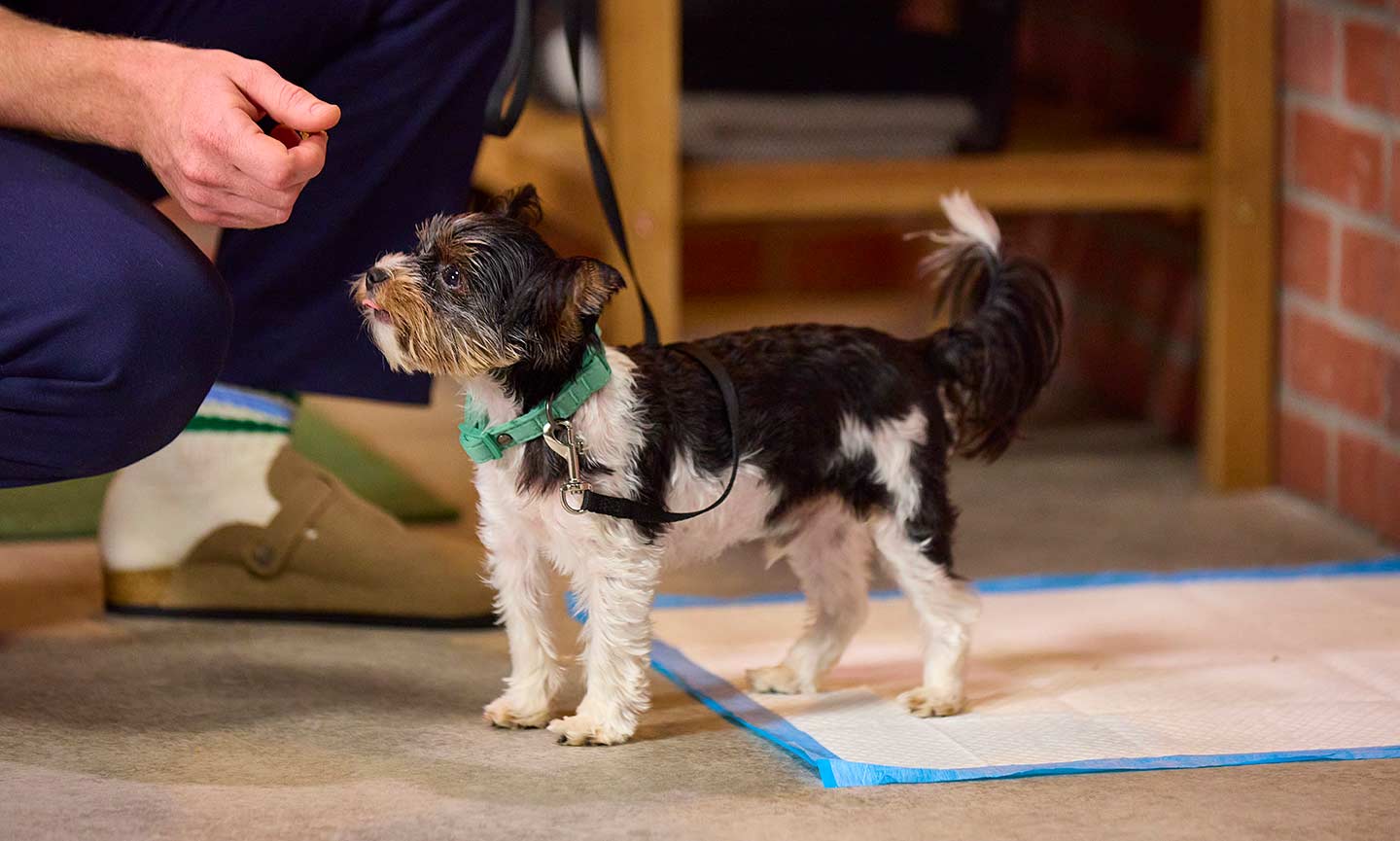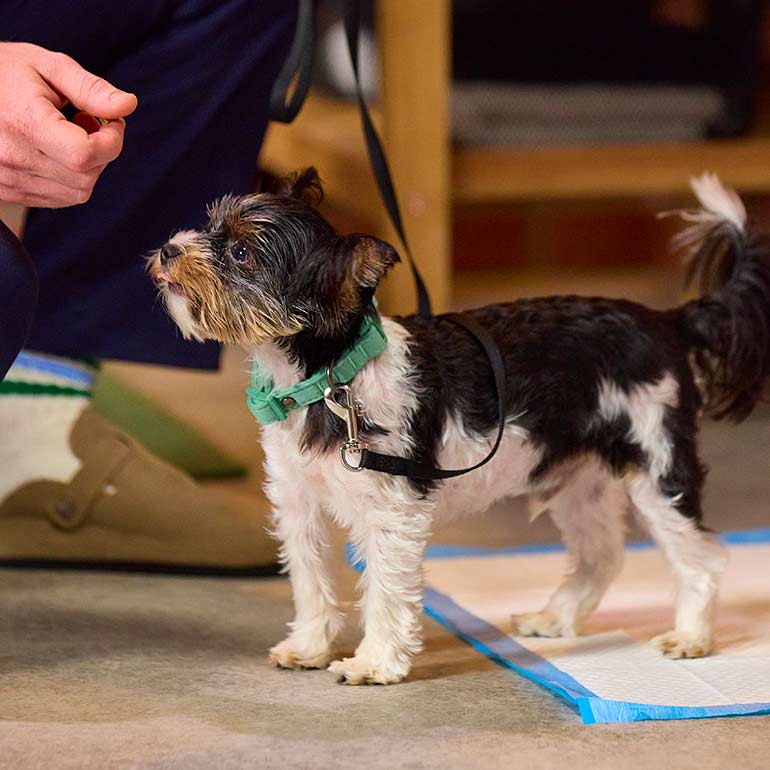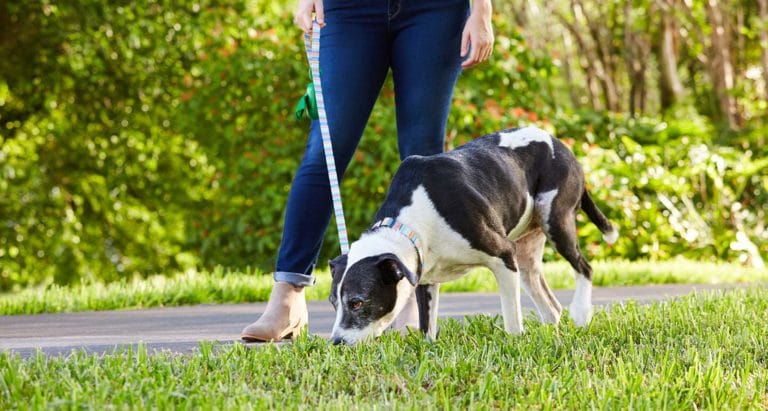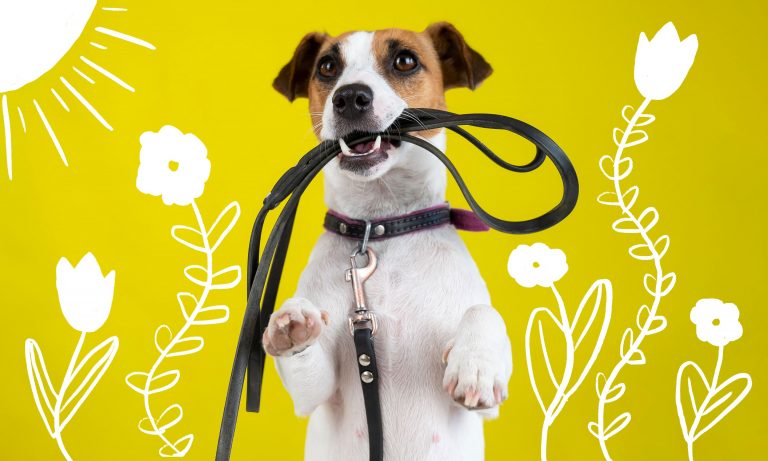Lots of dogs love being outside—but your pooch may not always have easy access to the outdoors. That’s when dog potty pads come in handy. They give your doggy a place to potty if they can’t wait to be let out. With a little practice and encouragement from you, your pup can learn to use dog pee pads to avoid accidents inside your home, while traveling and beyond.
In This Guide
Why Should I Use Pee Pads?
While many dog parents would prefer that their dogs did their business outside, pee pads (aka potty pads) can be a blessing for you and your pup in a number of situations. Birgit Walker, a dog trainer based in Phoenix, Arizona, recommends using potty pads for dog pee and poop in these scenarios:
- Traveling: Planes, trains and boats are a tricky place to be when it’s potty time for your pup. These modes of transportation don’t always provide the opportunity to take your dog outside for relief, notes Walker: “With the potty pad, you can let the dog out of the crate in a secluded corner or area and let them go there.”
- Leaving Your Dog at Home: Walker suggests using pee pads in your home whenever you have to leave for an extended period of time and won’t be home for potty breaks. “If the dog doesn’t have a way to get out, you can teach them to have a certain area in the house where you want them to go,” she says.
- Crate Liners: If you need to leave your dog in a crate for a while, Walker suggests lining the crate with potty pads in case they need to eliminate. (Do note that dogs don’t like to pee where they nap, so this should only be a final resort—not the norm.)
- House Training for Puppies: Puppy pads come in very handy when you potty train a puppy. Puppies in particular are more susceptible to germs and diseases, says Walker, and they shouldn’t always go outside in public places. If you don’t have a private lawn and your puppy hasn’t had all of their shots, you can use a potty pad inside before moving it outside to teach them to go in the yard.
- Training a Senior Dog to Go Inside: Along with housebreaking young and old puppies, potty pads are a good option for senior dogs (or incontinent dogs) that may struggle to make it to the door in order to potty outside. Having a potty area inside with a leak-proof potty pad can help prevent accidents.
How To Potty Pad Train Dogs: A Step-By-Step Guide
1Train Your Dog to Go to the Bathroom on Command
Training dogs to go on command is helpful for puppies, senior dogs and every age in between, Walker says—especially if you’re in new, distracting surroundings. A busy area with lots of commotion, like an airport, might cause them to forget the task at hand.
To train your dog to potty on command, use a consistent word cue before your dog does their business, such as, “Go potty.” For dogs who have already been through house training, use the command before they go to the bathroom every time you take them for a walk or let him outside. For new puppy training, look for other cues and times of day—especially right after the dog has woken up, after they’ve played a lot, or after they’ve eaten, says Walker.
“They're learned it when you take them out and say ‘go potty!’(or whatever your cue is) and they go,” says Amanda Farah, National Training and Behavior Coordinator at Best Friends Animal Society. “They've really learned it when you say the cue when they don't actually have to go and they fake a potty. Not sure you need that part, but I've seen it dozens of times.”
Whenever you use the command and your pup goes, make sure to heap on the praise. Positive reinforcement is a very important aspect whether you’re teaching them how to have a successful potty or a fun new trick.
2 Find a Good Potty Spot For the Pee Pad
Where you put the potty pad can help with dog training. For older dogs who have already been through house training, Walker suggests putting the potty pad in the area where you usually walk your dog or where they usually go to eliminate in your yard.
Farah says that moving the pad around for training purposes is helpful, and that it can even serve as an important training step if you want your puppy to be able to use a pad during travel. However, if you’re using the pee pad for daily use—like in the case of a senior pup or other dog who needs to be able to go potty in the house during the day—it’s best to keep the pad in a consistent location.
On that note, when you’re puppy training with a potty pad, try to confine your dog to a small area with the potty pad. This can be in a playpen, or a small area of your home. Walker suggests using dog gates in a hallway or other secluded space so your puppy only has a small area in which they can go to the bathroom.
3 Introduce The Potty Pad
Always put your dog on a leash before you start using the potty pad. “Many people will put the potty pad down somewhere and hope the dog finds it, but it’s important for behavior that we show the dog what to do,” says Walker. A leash is crucial for this.
Use the leash to guide your pup onto the pad, then say “go potty” or whatever other training cue you’ve chosen. If training your pup with a pad outside, you’ll eventually be able to move the potty pad into the house and continue training there.
If your pup is well-trained to go potty on command, they might just eliminate on the pad on cue. If not, keep trying, focusing on times when your dog typically needs to do their business, like 20-30 minutes after eating or just waking up.
4 Reward Your Dog's Successes
Every time you cue your dog to pee and they use the pad, make sure to give them praise with lots of enthusiastic words and yummy dog treats. Ultimately, you want to form a positive association with them using the pad.
5 Stay Consistent
Don't ease off the training after just a few successes. Keep taking your pup to the pee pad and cueing them to eliminate—always followed by praise and treats when they do. Eventually, your dog will start using the pee pad without being cued. When that happens—you guessed it—heap on even more praise and treats!
With consistent training, Farah says, your dog can become trained to use pee pads within a week’s time. But the key word there is “consistent”—if you take a break or allow your puppy to roam freely and eliminate wherever they want, it can take much longer.
What Are the Best Pee Pads for My Dog?
You’ll find lots of pee pads out there, but which one is the best?
“I'd start with the largest potty pad you can find—regardless of the size of the dog—to make the target easier,” says Farah. You can gradually go smaller if you need to once they're using it consistently. Try something like the Frisco Extra Large Dog Training & Potty Pads.
Walker also recommends using fully-lined, leak-proof, disposable pads because they’re easy to clean up and great for travel. Frisco’s premium potty pads have both, as well as five absorbent layers to further protect your floors. They come in three sizes and feature a built-in attractant that’s good for house training puppies as well as potty pad training indoor dogs.
If your dog seems resistant to using a pad and is used to usually going outside, you may find that they prefer a product with the natural look and feel of grass. In that case, choose a washable, reusable product like the Four Paws Wee-Wee Dog Grass Patch Tray, which mimics the outdoors. The pads have a removable grass-like top layer and a durable tray underneath with a pour spout that makes cleanup easy.
Common Mistakes When Potty Pad Training
- Lack of training: If you put the potty pad down and think your dog should somehow know that that’s where they’re supposed to go, you’ll be disappointed, says Walker. Using a leash means you can guide your dog to the potty pad when it’s time and show them the behavior you want them to do.
- Inconsistency: “Many pet parents don’t realize how often dogs—especially puppies—have to use the bathroom,” says Walker. She suggests near-constant supervision, especially at key times like right after they get up in the morning and 20-30 minutes after your dog has eaten. At these times, either keep a very close eye on your pup or confine them to a small space until you can take them to the potty pad.
- Over-Excitement: Would you have a harder time going to the bathroom if there were someone standing over you and shouting? So would your puppy. So stay calm and ignore the impulse to repeat your potty command over and over. Instead, firmly give the command once and let your dog just be for a moment. They just might surprise you!
Potty training your dog to use a pee pad is a real game-changer for both pet parents and dogs. It means fewer accidents to clean up, less stress for you and your pooch, and a solution for situations when getting outdoors to pee and poop isn’t an option. Stay the course, give your pup lots of positive reinforcement, and they’ll be pad trained in no time!
More Potty Tips for Your Pup
Share:







